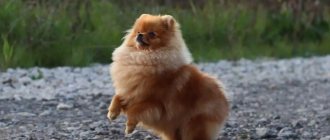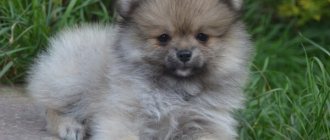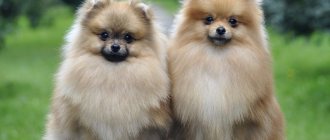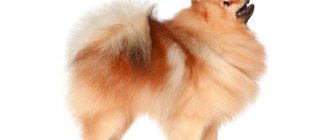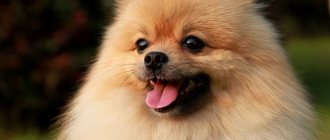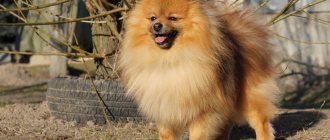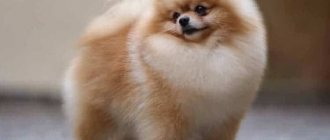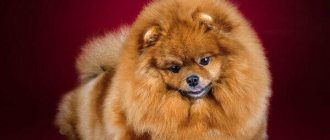There are a sufficient number of animals in the world that will not leave anyone indifferent. Among dogs there are also many breeds that conquer the hearts of people from the first meeting. A miniature dog with plush fur, a bear-type Pomeranian. This variety is similar to a soft toy. However, any pet requires care and attention. Before you get a cute pet, you should understand the intricacies of keeping a Pomeranian.
Characteristics of Pomeranian Spitz Bear
The bear-type Pomeranian has special characteristics associated with the structure of its muzzle. They have a round head with a short and slightly flattened snout. The eyes are close to each other, and the nose looks up. The colors come in a variety of colors. The body constitution of all Spitz dogs is no different: their weight reaches three kg, height at the withers is from 12 to 22 cm, a bushy tail and slender muscular legs.
A boy and a girl of a bear-type Pomeranian have obvious external differences. The female looks much more elegant and graceful, and the boys look more stately and “busty”.
Why do you need to know the sex of an orange?
You need to know the gender of your future pet in order to be prepared for the peculiarities of its behavior. As already noted above, there are slightly more problems with Pomeranian boys than with girls. Females are easier to train, but males do not “throw away” their affection and are devoted only to their owner.
However, both sexes experience problems during periods associated with estrus and mating. If the owner does not intend to breed Pomeranians, there is no need to neglect castration of the pet.
External uniqueness
The unique thing about Bear-type Pomeranians is that they look like a tiny bear cub and have a large amount of fluffy hair on their cheekbones, which gives the appearance of “cheeks” and a smile. And the baby with a special haircut resembles a toy.
At 8 months old, a small bear-type Pomeranian already looks like an adult dog.
Bear type Pomeranian breed standard
According to the standards set by the FCI, the description of the “ideal” Pomeranian pet of German origin must meet many parameters:
- The very first and most important thing is height. At the withers it should be twenty cm (plus or minus a maximum of two cm). FCI does not take into account body weight.
- Next, the shape of the head, chest, back, bite and degree of fit of the lips to the jaw, and even gait are assessed. In addition, the pigmentation of the eyelids, the shape of the ears and many other strict physiological parameters are important.
Varieties
Mini or dwarf (micro) bear-type Spitz
The favorites of Queen Victoria of England, these dogs are admired by a large number of people. The maximum size that an adult bear-type mini Pomeranian can reach is 22 cm, and the length of the face is from 3 to 5 cm.
To obtain ultra-short muzzles (less than 1 cm), breeders conduct genetic experiments on “fluffies”. Unfortunately, artificially bred micro “renewed” Spitz live very short lives and have many serious health problems.
Historical reference
These dogs once weighed much more. Until 1700, they were bred in Pomerania and were white in color. Later the nobility became interested in them. As a result of selection, their weight and size have decreased to what we are used to.
In the 18th century, the dog of common people turned into the star of secular salons. Queen Victoria began buying smaller Pomeranians and founded her own kennel. In 1871, thanks to her efforts, a breed standard was adopted. The fashion for miniature Spitz dogs has also come to Germany, the USA, Holland, Russia, and France.
Now it’s hard to believe that Pomeranians are an offshoot of Icelandic and Scottish sled dogs. Modern pomas will not be able to pull a team like their ancestors. These are lap dogs. But their temperament was preserved. If you want to have a loyal friend, choose a Pomeranian “bear”.
Color options for the bear-type Pomeranian
White Pomeranian Spitz Bear
This dwarf bear-type Pomeranian is considered the most expensive subspecies. They brought him out in Japan. They should not be confused with albinos. The puppies of this Pomeranian have a special recessive gene that prevents their fur from coloring, but the snow-white pets have dark skin and claws.
Brown (chocolate)
The bear-type Pomeranian, which has a brown coloring, is also rare. A dog of this color looks like a real brown bear cub. The standard includes a dark chocolate coat without any spots.
Sable shade
This is a fairly common color, consisting of gray and reddish shades. Zoologists claim that it is correct to call this coloring “zonal” and divide it into several types.
Red shade
Red bear-type Pomeranians are the most numerous and popular species. With this coloring, some parts (for example, ears, “pants” or tail) have lighter orange shades than the main body of the body.
Black bear type Pomeranian
Classic antique coloring is now very, very rare. This is due to the fact that to breed a truly black Miniature Spitz, you only need the same representatives in its family, so today’s “charcoal” Pomeranian bears have patches of light shades in their coats.
Cream Pomeranian bear type
This shade has many variations: from snow-white to sand. Therefore, true cream Pomeranians of the bear type are very difficult to recognize among the small “fluffies” of snow-white or orange color.
Other
There is another type of color for the bear-type Pomeranian Spitz - gray, or in other words silver. At birth, such babies have a “charcoal” fur color, and later it thickens and brightens.
Wool shades
Pomeranian coats come in different types. The most common shade is red and fiery red. In addition, dogs come in black, white, brown, beige, and other colors.
It is possible to understand exactly what shade the dog will have only closer to the age of one, since the color is not determined immediately after birth.
Care and maintenance of the bear-type Pomeranian
The bear-type Pomeranian, like any pet, requires careful care and maintenance, even despite its mini size. Below we will consider all the necessary procedures for a pet.
The right diet
Bear-type Pomeranians have a fast metabolism and a very good appetite. And the main point in forming the right diet is not a variety of different types of food, but a balanced ratio of nutrients that the dog needs.
The advantages of feeding ready-made food are quite tempting: you don’t have to waste time on preparation and calculate the required daily intake. In addition, each package contains exactly as many beneficial nutrients as your pet needs. If the owner is determined to feed his pet ready-made dry or wet food, it is important to choose a suitable line of food:
- First of all, you need to pay attention to the packaging: food for small pets is marked “small” and “mini”.
- The premium food class is represented by the brands “Doctor Alders”, “Happy Dog”, “BioMill”, “Pro Pac”. They contain meat and various vegetables and grains.
- The super-premium food class is represented by the brands Royal Canin, Hills, ProPlan, Nutro Choice. Such food is as close as possible to the benefits of natural food.
- Environmentally friendly food is represented by the brands “Acana”, “Chicken Sup”, “Pronature”, “Orijen” and so on. They do not contain any hormones or chemicals.
If the owner prefers to feed his Pomeranian with natural food, it is important to know the following:
- 35% of the total diet should consist of boiled or raw lean meat (for example, chicken), boiled eggs, fermented milk products (for example, kefir or natural yogurt). Fish can be given no more than twice a week, after removing all the bones from it. If the fish is from the sea, you can give it raw. River water should be boiled.
- 10% of the total diet consists of porridge. Of course, cooked in water and without salt. Rice, buckwheat, and barley are suitable.
- To meet the carbohydrate needs, you can give your dog fruits and vegetables. Among them are zucchini, cucumber, radishes, carrots, cabbage, apples, bananas and pears.
- Vitamins are mandatory in a natural feeding system. For the bear type, the vitamin complexes “Beaphar Irish Cal”, “Excel Mobile Flex+” and many others are perfect. You should first consult a veterinarian. An overdose of nutrients is no less dangerous than their deficiency.
Vaccination
Before taking your pet for vaccination, you need to carry out deworming, eliminate stressful moments, and on the day of the vaccine itself, do not feed the dog. The very first vaccination is given only upon reaching two months of age. The vaccination regimen and schedule is usually prescribed by a veterinarian, but it often looks like this:
- At 8-9 weeks, vaccinations are given against hepatitis, plague, parainfluenza, enteritis, and leptospirosis. At 12 weeks, the same complex is repeated a second time. When the puppy turns 6 months old, he is vaccinated against the same diseases for the third time. At the age of 1 year, revaccination is carried out again.
- At 8 months a rabies vaccine is given.
Next, the pet is vaccinated every year, according to the schedule, that is, at 2 and 3 years old, and so on.
After vaccination, quarantine begins, when the dog is not allowed to walk for 10-14 days, much less have contact with other people’s animals. During this time, the pet will develop a strong immune system.
Walk
People mistakenly believe that a walk with a dwarf Pomeranian is only necessary for this teddy bear to relieve itself. First of all, the dog needs physical activity and constant movement. And fresh air has a beneficial effect on your pet’s circulatory system. By the way, it is on the street that it is best to train him.
The duration of each walk should be at least two hours a day. Going outside for five or ten minutes will not do any good.
A few tips to make your walk safe:
- if it is very cold outside, you need to put insulated overalls on the “fluffy”;
- there is no need to allow the Pomeranian to eat anything from the ground;
- After each walk, carefully examine your pet for ticks and wounds;
- do not remove the leash from him in crowded places and pick him up if you are going to cross the road.
Taking care of your pet's fur
A purebred pet should be bathed no more than once every 1-2 months. For washing, you need to use a special shampoo for long-haired breeds. It is not recommended to put your pet in the bath unless necessary. There is also no need to do this during the molting period.
You need to comb your pet 2 times a week against hair growth. You shouldn’t do this too often; it will remove the “fluffiness” of your pet.
It is allowed to cut a bear-type Pomeranian from three months, but not shorter than three to four cm: a pet cut too short can suffer from sunstroke and insect bites in the summer, and in the cold season it can become very cold. The risk of dermatitis and cancer also increases.
Oral and dental hygiene
Your pet's teeth should be brushed at least three times a week. You need to purchase special toothpaste and a brush with soft bristles. This seemingly ordinary procedure prolongs the pet’s life by 20%.
Nail trimming
Untrimmed and long nails will cause a lot of discomfort to the Pomeranian Spitz, and in advanced cases they provoke a crooked posture. You can trim the nails yourself, or you can do it at a veterinary clinic.
If the owner is ready to do this himself, then he needs to cut off the tip of the claw with a special nail cutter at an angle of 45 degrees, leaving a distance of 2 mm to the pulp. If the pulp has been wounded, you need to treat it with a solution of potassium permanganate and iodine.
Caring for your ears
Once a week you need to clean your pet's ears. This can be done using a soft napkin. There are also ear drops with antibacterial properties.
Taking care of your eyes
If “tears” have accumulated near your pet’s eyes, you need to carefully rinse them with warm boiled water. Most often, the animal's eyes suffer from heat, cold and wind. Therefore, during such a period they require additional care.
Nutrition
There is one important thing you should remember throughout your dog's life - he needs a balanced diet. You should carefully read the label before purchasing food. The veterinary manual prescribes that the dog’s diet should provide a minimum protein content, namely 18% per day. Also a minimum fat content, namely 5% per day. It is important to find a food that contains omega fatty acids, vitamins and minerals. Avoid foods that contain a lot of chemical ingredients and dyes.
What kind of human food can you give to your pet?
You can also give Pomeranians human food. These include:
- Sources of protein. Chicken, turkey, lamb, fish, beef liver, chicken liver, pork, venison, shrimp, crawfish.
- Vegetables. Asparagus, beets, bell peppers, broccoli, cauliflower, carrots, cucumber, green beans, cabbage, spinach, lettuce, peas, potatoes, zucchini.
- Carbohydrates. Porridge, pasta.
- Natural fats. Sunflower seeds, peanut butter, peanuts, flaxseeds, cashews.
- Other products. eggs, cottage cheese, cheese, honey, apples, banana, blueberries, melon, kiwi, oranges, nectarines, peaches, pear, pineapple, plums, pumpkin, mango, raspberries, strawberries.
Avoid giving your Pomeranian the following foods frequently: bread, crackers, coconut, popcorn, potato chips, marshmallows, bacon, pancakes, waffles. They may upset your friend's digestion.
Never feed Pomeranians the following foods: onions, garlic, chocolate, grapes (including juices, jams and jellies), raisins, currants, cinnamon, mushrooms, pecans, walnuts, macadamia nuts, cherries (and other small-seeded fruits) or seeds), yeast dough.
An adult Spitz should consume the following amounts of food per day, depending on weight and activity:
- 1 kg – from 24 to 31 g.
- 1.5 kg – from 32 to 42 g.
- 2 kg – from 40 to 53 g.
- 2.5 kg – from 47 to 62 g.
Pomeranians burn calories much faster than some other breeds. This is due to their small size and high activity level. Divide your pet's food into three or four meals per day. This will help the animals continuously produce the required level of energy.
Difficulties of breeding
Breeding bear-type pets is a rather difficult and time-consuming task. The fact is that girls endure childbirth hard and often endanger their lives and the lives of their babies. And boys have little interest in reproduction. In addition, in order to obtain ideally purebred offspring, the pet must belong to the breeding class (i.e., have excellent reproductive capabilities and heredity).
And looking after a pregnant female will require regular visits to the veterinarian and a lot of time.
Education and training
There is an opinion that it is possible to train a miniature bear-type Pomeranian dog only when the little pet is six months old. But modern training methods are devoid of coercion and cruelty, so training can be done immediately after the pet has crossed the threshold of the house. At 2-3 months the puppy will be at home, in quarantine after vaccination.
So, what things should you accustom your pet to:
- Toilet. Up to a year he will do this in a diaper.
- Collar and leash. It is better to do this in advance at home, before the first time you go outside.
- Boundaries of what is permitted. This includes a ban on biting and gnawing things, furniture in the house, following a certain daily routine, and getting used to being alone.
- Teams. For example, “To me”, “Nearby”, “Sit” and so on. There is no need to resort to punishment if the dog cannot get used to commands right away.
How to raise a dog
Although Spitz dogs are very small, they love to attack larger dogs. To prevent this, you need to start training your pet in a timely manner. The bearish Spitz is very smart, and his desire to please the owner will contribute to training.
Raising Pomeranian dogs is quite easy, the main thing is to adhere to certain conditions:
- Be patient, any training requires time and effort.
- Treat the animal kindly so that the animal is kind and obedient.
- Sometimes you need to be firm and stand your ground, but without being too harsh. If you raise your voice, much less raise your hand to the baby, the dog will probably grow up disobedient and angry.
- If the dog has done a good deed, be sure to “encourage” him.
By following these recommendations, you can raise a loyal friend and an excellent companion. When you feel sad, the “bear cub” will help you cope with depression, especially if you did not have time to start a family.
How long do Spitz live and what health problems do they have?
The life expectancy of a Pomeranian is from 12 to 18 years, and depends, first of all, on the quality of care for the Spitz, and on its size. As a rule, larger individuals live longer.
The tiny dimensions of the Pomeranian Spitz, unfortunately, often provoke the appearance of various diseases in the pet:
- Complications related to teeth. Baby teeth have long roots, which causes problems with their natural loss.
- Problems with the eyes, frequent tearing. Due to the special structure of the skull (a sharp transition from the forehead to the nose), the eyes of the Pomeranian bear cub are extremely sensitive and vulnerable, so even dust or heat outside makes the Pomeranian “cry”.
- Hypothyroidism. This is a hormonal disease that causes malfunction of the thyroid gland. The pet becomes lethargic, gains a lot of weight, itchy rashes (dermatitis) and baldness appear on the skin.
- Diseases of joints and bones. Bear-type Pomeranians are prone to frequent sprains and other injuries due to weak ligaments and thin bones.
- Epilepsy. Genetic pathology does not manifest itself immediately, but only when the pet is two years old.
Tendency to diseases
Spitz are dogs with good health. They are distinguished by their longevity. With good care they live up to 20 years. But even they can be plagued by diseases that you need to know about:
- diseases of the musculoskeletal system (necrosis of the femoral head, subluxation of joints, dislocation of the patella);
- complications during labor;
- bulging eyes characteristic of dwarf breeds;
- eye diseases (including cataracts, entropion, retinal dysplasia and atrophy);
- complications with teeth (especially during their change).
- inguinal and umbilical hernias;
- heart diseases;
- breathing problems, frequent coughing and sneezing.
Pros and cons of the Pomeranian Teddy
These plush pets are endowed with many advantages:
- First of all, they have a very high level of intelligence and the ability to learn quickly. The bear-type Pomeranian is perfectly trainable, and if you start training with a tiny Pomeranian, the adult dog will be obedient and well-mannered.
- Cleanliness. The pet constantly licks its silky coat, reminiscent of a cat.
- Loyalty. This dog is the most devoted friend who will love every family member until the last day of his life.
- Love for people. The four-legged “bear” loves to communicate and play with people, and does not show aggression towards them.
The “disadvantages” of a pet are associated not only with its behavior, but also with physiology. So, among the disadvantages are:
- Loud barking. The Pomeranian Spitz is so “talkative” that you need to be prepared - this teddy bear will bark for any reason. The house will be filled with barking not only when there is a sense of danger, but also from the slightest joy of the pet. But, fortunately, a Pomeranian dog can be weaned from this habit.
- Aggression towards opponents. Harmless on the outside, the pet is ready to fight with an opponent who will be many times larger than him.
- Weak joints and bones. You should try to protect your pet from jumping from great heights.
- Tendency to be overweight. You need to be careful about your pet’s diet, do not overfeed and walk your dog often.
- Price. Pomeranian Spitz is not a cheap pleasure, which also requires quite a bit of money on food, regular haircuts, and the like.
Documentation
Along with the Pomeranian Spitz puppy, a specialized breeder is obliged to give you documents on the transfer of ownership:
- pedigree;
- registration documents;
- list of vaccinations done;
- a reminder about future vaccinations and deworming;
- description of the diet;
- meal schedule.
Don't forget to check your puppy for marks.
The above information will help you with choosing a Pomeranian puppy. If you have any questions, you can ask them to the potential seller. He will not only answer you with pleasure, but also share his experience.
Now you are a full-fledged owner of a purebred Pomeranian Spitz, and the future of the dog will depend only on your proper maintenance, care and education.
Did you like the article? How did you approach the issue of choosing a Pomeranian puppy?
Choosing a bear type puppy
Before buying a bear-type mini orange, you need to determine the desired color of the baby: white, black, cream or any other. Then you need to examine his fur coat, the condition of his mouth and eyes. Pay attention to the conditions in which the baby was kept before sale.
Where to buy and how much does a Pomeranian cost?
The cost of the bear-type Pomeranian is quite high due to their popularity; German species cost around 25-30 thousand rubles. The price is affected by color, gender, age group and class. Thus, snow-white dogs—girls, older individuals, and those belonging to the show class—are considered the most expensive. The price for a snow-white Spitz can reach 150 thousand rubles, for an orange one - from 50 to 80 thousand rubles.
You can buy a pet:
- in the nursery. You can find reviews confirming its reputation;
- from experienced breeders;
- at exhibitions;
- on online trading platforms (for example, Avito).
Curious facts
Interesting facts that many people don't know:
- The name of the pet translated into Russian means “spicy”. And in Germany, a “Spitz” is a swindler or swindler.
- In the Middle Ages, the white Pomeranian, whether a puppy or an already grown bear cub, was considered a messenger of the gods and was equated with an incredible unearthly creature.
- All Miniature Spitz dogs love sweets. Therefore, you need to hide all the “goodies” well away from the Pomeranian.
- According to some old legends, Pomeranians were companions of the wise men who carried gifts to Jesus Christ.
Character
The friendly nature of the little dog will appeal to any breeder. The Pomeranian is sometimes called the smiling bear, as it has a special cheerfulness and love. The Pomeranian easily gets used to the new owner and his habits. The owner of this type of breed will not have to change his daily routine and usual way of life, because the dog itself will easily adapt to the person. The activity and energy of the little bear cub is amazing. He is able to play for long hours without getting tired at all. His cheerfulness, optimism and fun will be the envy of any other animal.
By the way, the Pomeranian very quickly finds a common language with all animals, be it a cat, dog, rat, hamster or chicken. The small pet also communicates well with people, regardless of the latter’s age - the dog will be friends with everyone, from a baby to an old man.
